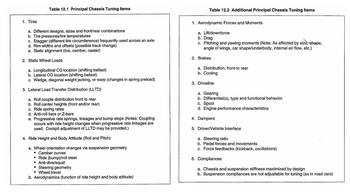
Elements Of Electromagnetics
7th Edition
ISBN: 9780190698614
Author: Sadiku, Matthew N. O.
Publisher: Oxford University Press
expand_more
expand_more
format_list_bulleted
Question
thumb_up100%
Summarize chassis configuration and adjustments for race cars emphasizing the data from the tables below:

Transcribed Image Text:1. Tires
Table 12.1 Principal Chassis Tuning Items
a. Different designs, sizes and front/rear combinations
b. Tire pressures/tire temperatures
c. Stagger (different tire circumference) frequently used across an axle
d. Rim widths and offsets (possible track change)
e. Static alignment (toe, camber, caster)
2. Static Wheel Loads
a. Longitudinal CG location (shifting ballast)
b. Lateral CG location (shifting ballast)
c. Wedge, diagonal weight jacking, or warp (changes in spring preload)
3. Lateral Load Transfer Distribution (LLTD)
a. Roll couple distribution front to rear
b. Roll center heights (front and/or rear)
c. Ride spring rates
d. Anti-roll bars or Z-bars
e. Progressive rate springs, linkages and bump stops (Notes: Coupling
occurs with ride height changes when progressive rate linkages are
used. Cockpit adjustment of LLTD may be provided.)
4. Ride Height and Body Attitude (Roll and Pitch)
a. Wheel orientation changes via suspension geometry
• Camber curves
•
Ride (bump)/roll steer
• Anti-dive/squat
• Steering geometry
• Wheel travel
b. Aerodynamics (function of ride height and body attitude)
Table 12.2 Additional Principal Chassis Tuning Items
1. Aerodynamic Forces and Moments
a. Lift/downforce
b. Drag
c. Pitching and yawing moments (Note: As affected by size, shape,
angle of wings, car shape/underbody, internal air flow, etc.)
2. Brakes
a. Distribution, front to rear
b. Cooling
3. Driveline
a. Gearing
b. Differential(s), type and functional behavior
c. Spool
d. Engine performance characteristics
4. Dampers
5. Driver/Vehicle Interface
a. Steering ratio
b. Pedal forces and movements
c. Force feedbacks (kickback, oscillations)
6. Compliances
a. Chassis and suspension stiffness maximized by design
b. Suspension compliances are not adjustable for tuning (as in road cars)
Expert Solution
This question has been solved!
Explore an expertly crafted, step-by-step solution for a thorough understanding of key concepts.
Step by stepSolved in 2 steps

Knowledge Booster
Similar questions
- Four months into a six month deployment, you are a solo pilot returning to home base after an uneventful overwatch mission to a non-disclosed desert location. Your mission was extended 90 minutes requiring at least one additional aerial refuel. The moon has now set. A shift in prevailing winds causes an infrequently used runway to be active. You are less familiar with the approach to this runway and have only used it during VFR conditions. The instrument approach plate reveals you will fly a prolonged DME arc taking you out over the unlit desert away from the dimly lit base. While flying the above instrument approach, you take another look at the approach plate. When you look up again the airfield lights are visible through the upper portion of your canopy. You did not sense any change in your aircraft attitude. Which of the following best describes what happened while you looked at the approach plate? OA. The black hole effect has amplified the normal reflection of the airfield lights…arrow_forwardCan you help with question2arrow_forwardDimensions: a. Can be placed only in model space b. Can be placed only in paper space c. Must be erased and redrawn if the model changes d. Are controlled by their associated dimension stylearrow_forward
- Question helparrow_forwardCan you help with question1arrow_forward5) 7(motors 20000 1000000 BOODD 60000 40000 20000 A projectile has an initial velocity of 2000 m/s at an angle of 45° above the horizontal. The projectile experiences an acceleration due to gravity and aerodynamic drag: 0 Determine the trajectory followed by the package and compare it with the trajectory with no aerodynamic drag. WITH DRAG 50000 100000 a = -9.81ĵ-0.0273 V² 150000 With Drag 200000 250000 x (meters) -Series2 300000 V m V S² WITHOUT DRAG 360000 400000 450000arrow_forward
arrow_back_ios
arrow_forward_ios
Recommended textbooks for you
 Elements Of ElectromagneticsMechanical EngineeringISBN:9780190698614Author:Sadiku, Matthew N. O.Publisher:Oxford University Press
Elements Of ElectromagneticsMechanical EngineeringISBN:9780190698614Author:Sadiku, Matthew N. O.Publisher:Oxford University Press Mechanics of Materials (10th Edition)Mechanical EngineeringISBN:9780134319650Author:Russell C. HibbelerPublisher:PEARSON
Mechanics of Materials (10th Edition)Mechanical EngineeringISBN:9780134319650Author:Russell C. HibbelerPublisher:PEARSON Thermodynamics: An Engineering ApproachMechanical EngineeringISBN:9781259822674Author:Yunus A. Cengel Dr., Michael A. BolesPublisher:McGraw-Hill Education
Thermodynamics: An Engineering ApproachMechanical EngineeringISBN:9781259822674Author:Yunus A. Cengel Dr., Michael A. BolesPublisher:McGraw-Hill Education Control Systems EngineeringMechanical EngineeringISBN:9781118170519Author:Norman S. NisePublisher:WILEY
Control Systems EngineeringMechanical EngineeringISBN:9781118170519Author:Norman S. NisePublisher:WILEY Mechanics of Materials (MindTap Course List)Mechanical EngineeringISBN:9781337093347Author:Barry J. Goodno, James M. GerePublisher:Cengage Learning
Mechanics of Materials (MindTap Course List)Mechanical EngineeringISBN:9781337093347Author:Barry J. Goodno, James M. GerePublisher:Cengage Learning Engineering Mechanics: StaticsMechanical EngineeringISBN:9781118807330Author:James L. Meriam, L. G. Kraige, J. N. BoltonPublisher:WILEY
Engineering Mechanics: StaticsMechanical EngineeringISBN:9781118807330Author:James L. Meriam, L. G. Kraige, J. N. BoltonPublisher:WILEY

Elements Of Electromagnetics
Mechanical Engineering
ISBN:9780190698614
Author:Sadiku, Matthew N. O.
Publisher:Oxford University Press

Mechanics of Materials (10th Edition)
Mechanical Engineering
ISBN:9780134319650
Author:Russell C. Hibbeler
Publisher:PEARSON

Thermodynamics: An Engineering Approach
Mechanical Engineering
ISBN:9781259822674
Author:Yunus A. Cengel Dr., Michael A. Boles
Publisher:McGraw-Hill Education

Control Systems Engineering
Mechanical Engineering
ISBN:9781118170519
Author:Norman S. Nise
Publisher:WILEY

Mechanics of Materials (MindTap Course List)
Mechanical Engineering
ISBN:9781337093347
Author:Barry J. Goodno, James M. Gere
Publisher:Cengage Learning

Engineering Mechanics: Statics
Mechanical Engineering
ISBN:9781118807330
Author:James L. Meriam, L. G. Kraige, J. N. Bolton
Publisher:WILEY